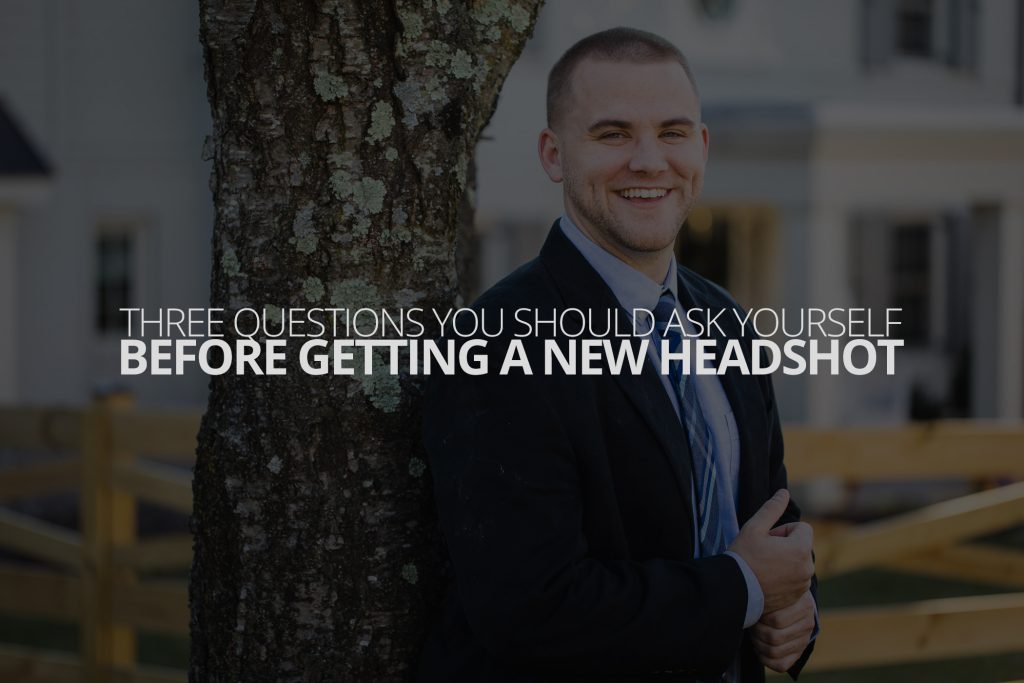As I mentioned in a recent photoblog, for anyone who needs to be noticed, a headshot is basically a necessity these days. The ubiquity of the social media ‘profile photo’ has trained us to put a sense of importance on the photo a person uses to represent themselves. It used to just be actors who ‘needed’ headshots. Then realtors caught on, and now even the hiring manager at your local craft store is going to punch your name into Facebook and LinkedIn before you get an interview.
Right now, in our business culture, a good headshot is just a step or two down from a resume, a business plan, or a rock solid elevator pitch—whatever your case may be. So if you are like the millions of other people out there who need to get noticed by a person or organization, then you should most likely consider a headshot among the bare minimums.
Now, a headshot is just means to a professional end; a tool you can use any way you like. While there are some things that all headshots should pretty much always have in common, there is no one right kind of headshot. A headshot is simply meant to represent you in a specific way to a certain person or people. Whether your headshot is moody, or mysterious, happy, funny, regal, professional, tongue-and-cheek, or anything else, should be dictated by your professional needs.
So, in this spirit, I suggest you consider these questions and answer them for yourself before you hire a photographer to create headshots for you. The answers to these questions will help you decide all the details, including what photographer to hire, and if you even need to hire someone in the first place.
Who needs to notice me?
Any time you’re doing something that requires an element of persuasion, the first and most important question is usually “who do I need to persuade?”. It’s not a question to be taken lightly. From getting the guy at 711 to spot you 5 cents, to getting the CEO of a huge hospital chain to hire you, to landing a dream investor, you have to know your audience in order to emphasize the things about personality that they’ll be attracted to.
So as you’re pondering getting this headshot made, ask yourself who this person is that will be looking at your photo. What kinds of things are important to them? What kinds of people do they spend their time with? What is it like to do the kind of work they do? What are you hoping they will do for you?
That last question was an important one here too, because someone hiring a realtor and someone hiring a janitor are doing the same thing in very different ways. Someone who is hiring an employee might have a stack of 30 resumes to look at, and they’re going to be scratching for ways to differentiate all these candidates. In some cases, you might be able to stand out from the pack by literally attaching a well considered photo directly to your resume. In most cases, that’s probably not a good idea unless you’re an actor. But regardless of the kind of work, you should expect whoever is hiring you to see what they can find on the internet—and hopefully they will find an excellent headshot you’ve created specifically to send the right message about who you are.
If you’re in business for yourself, or your work hinges on sales and networking, then a good headshot (or headshots) are much more important. A headshot becomes an important part of your brand and lets an individual, whether working independently or within an organization, take advantage of the mere exposure effect to their benefit. So the people you need to notice are your existing clients, or your ideal clients, perhaps they are investors or potential business partners. Whatever the case, ask yourself who these people are and have your headshot created for these people.
What impression do you want to send?
This question piggy backs on the last one, though also begs you check in with your values. It’s not enough to have someone to talk to, you also need something to say, and you have to decide if you should say it. So as you’re considering your headshot, and the people you hope will see it, what do you want your headshot to communicate? It ought to communicate something more than ‘this is how my face looks’, but what?
The answer to this question is going to be found somewhere in what you hope to be doing (e.g., working in a dentist office, landing an investor, getting more clients for your woodworking business). Think about what kind of person should be doing what you hope to be doing, and show that off in your headshot. For example, you could guess that the hiring manager at a dentist office probably wants to find someone friendly, empathetic and outgoing. Those are the qualities your photographer should find ways to imply or emphasize in your headshot. Likewise you can bet that an investor is looking for someone trustworthy who has their act together. If that’s true of you, then you’re photographer can help to create that impression.
Sending an impression though isn’t just what you look like in your headshot, or what a photographer tells you to do. The photo itself is also sending an impression and this is where you might find it better not to hire anyone at all. Consider this—if you’re trying to get a part time job at a computer repair store, when the hiring manager looks you up on the internet, a professional headshot might actually put them off. In that context, you might seem overqualified or much worse, like you think your overqualified. And on the exact flip side, if you want someone to buy a house from you, using some standard selfie is going to send your prospective client the other way—toward someone presenting themselves more professionally.
Where will I be looking for attention?
If you’ve gotten this far and still need to hire a photographer for a headshot, the gears should be starting to turn in your head. Now, this last question helps to fill in some of the gaps left over. The question is about where people are going to see your headshot, and by extension, what state of mind they are in at the time, and by further extension, what you might consider wearing, how you’ll do your hair and even how ‘formal’ looking your images should be.
If you’re looking for employment in management or at the executive level, then you can pretty safely assume that you’re images will be seen on any public, identifiable social media profiles you may have—Facebook, Twitter, LinkedIn, Instagram. You might want to consider making personal profiles private, but regardless, a setting that looks familiar, clothing reminiscent of what you expect to wear at the office, and maybe giving just a little extra love to your hair (frizzy or unkempt is exaggerated in a headshot), is likely the wisdom this question offers.
If you’re in sales, providing a service, freelancing, or doing anything else that requires you win and hold people’s attention, then this question creates more nuances.
While it’s generally best to use the same, or very similar, photos on all of your profiles and marketing materials, users on different social media platforms tend to have different expectations for a profile photo. For example, Facebook profile photos are often more personal in nature and tend to change more often. Twitter profile photos are often humorous, thematic, snarky, or aren’t photos at all—and they often do not change. Instagram is a lot like Twitter, but with a little bit of an artsy flare. And LinkedIn, as you would expect, has a lot of classic and professional headshots.
Here’s the thing, if you’re going to use the same headshot everywhere—which you probably should—you don’t have to use LinkedIn as the model. Instead use whichever platform is the most important to your business or work, as the model. If you’re mostly using Twitter, then bring the personality of your ideal twitter profile over to your other profiles. If most of your clients know you from Facebook, use a more personal-looking but well considered photo on Twitter and LinkedIn too.
For entrepreneurs, business owners and sales people, how to most effectively create and deploy your headshots can get a little complicated and nuanced from a branding perspective, but this is what a photographer and other professionals can help you with, and it’s well worth the cost and effort.
In Conclusion
I hope hope you’ll sit and ponder some of these questions before you pick up the phone and call a professional. Just having given these a little though will make your phone calls and planning go so much easier, though an excellent photographer should help you navigate these questions as well—or at least help connect you with a branding professional who can offer their guidance.
If you’re interested in learning about our headshot services, check out the page for professionals here on our website, or just shoot us an email!

